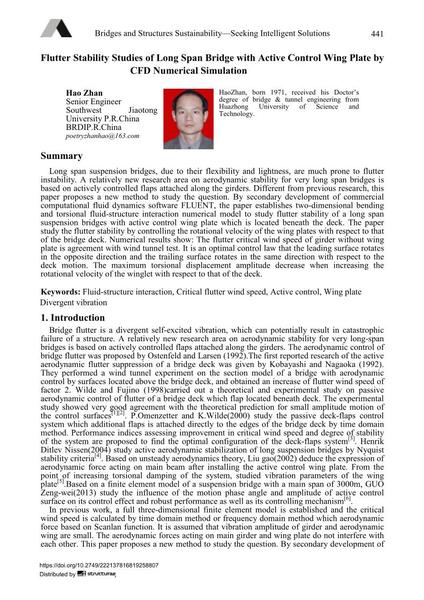Flutter Stability Studies of Long Span Bridge with Active Control Wing Plate by CFD Numerical Simulation

|
|
|||||||||||
Détails bibliographiques
| Auteur(s): |
Hao Zhan
|
||||
|---|---|---|---|---|---|
| Médium: | papier de conférence | ||||
| Langue(s): | anglais | ||||
| Conférence: | IABSE Conference: Bridges and Structures Sustainability - Seeking Intelligent Solutions, Guangzhou, China, 8-11 May 2016 | ||||
| Publié dans: | IABSE Conference, Guangzhou, China, 8 – 11 May 2016 | ||||
|
|||||
| Page(s): | 441-447 | ||||
| Nombre total de pages (du PDF): | 7 | ||||
| Année: | 2016 | ||||
| DOI: | 10.2749/222137816819258807 | ||||
| Abstrait: |
Long span suspension bridges, due to their flexibility and lightness, are much prone to flutter instability. A relatively new research area on aerodynamic stability for very long span bridges is based on actively controlled flaps attached along the girders. Different from previous research, this paper proposes a new method to study the question. By secondary development of commercial computational fluid dynamics software FLUENT, the paper establishes two-dimensional bending and torsional fluid-structure interaction numerical model to study flutter stability of a long span suspension bridges with active control wing plate which is located beneath the deck. The paper study the flutter stability by controlling the rotational velocity of the wing plates with respect to that of the bridge deck. Numerical results show: The flutter critical wind speed of girder without wing plate is agreement with wind tunnel test. It is an optimal control law that the leading surface rotates in the opposite direction and the trailing surface rotates in the same direction with respect to the deck motion. The maximum torsional displacement amplitude decrease when increasing the rotational velocity of the winglet with respect to that of the deck. |
||||

